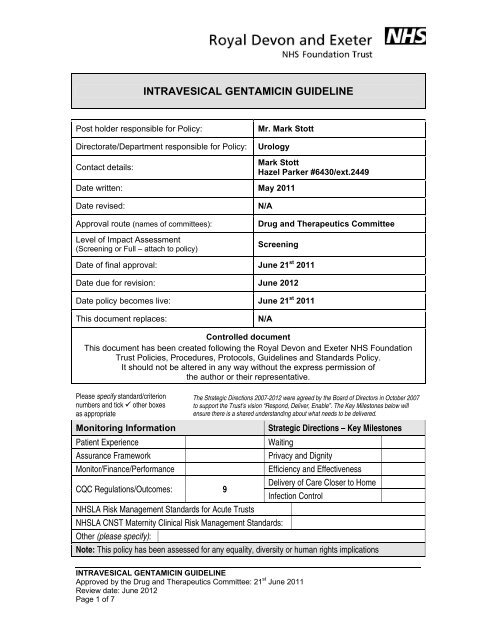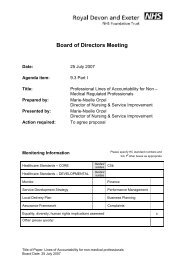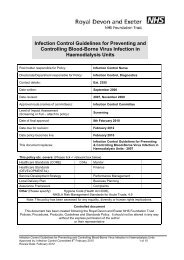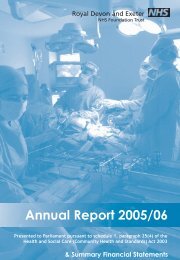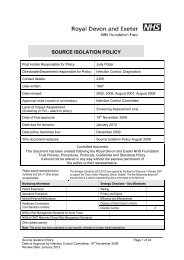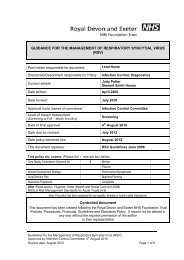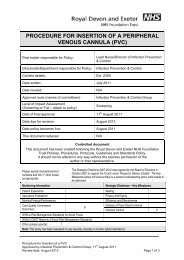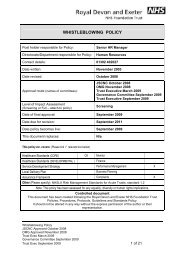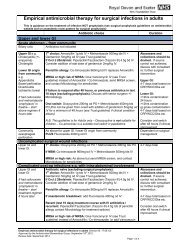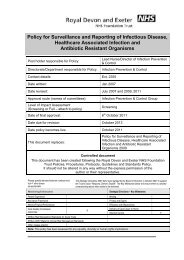Intravesical gentamicin protocol - Royal Devon & Exeter Hospital
Intravesical gentamicin protocol - Royal Devon & Exeter Hospital
Intravesical gentamicin protocol - Royal Devon & Exeter Hospital
- No tags were found...
You also want an ePaper? Increase the reach of your titles
YUMPU automatically turns print PDFs into web optimized ePapers that Google loves.
INTRAVESICAL GENTAMICIN GUIDELINEPost holder responsible for Policy:Directorate/Department responsible for Policy:Contact details:Mr. Mark StottUrologyMark StottHazel Parker #6430/ext.2449Date written: May 2011Date revised:Approval route (names of committees):Level of Impact Assessment(Screening or Full – attach to policy)N/ADrug and Therapeutics CommitteeScreeningDate of final approval: June 21 st 2011Date due for revision: June 2012Date policy becomes live: June 21 st 2011This document replaces:N/AControlled documentThis document has been created following the <strong>Royal</strong> <strong>Devon</strong> and <strong>Exeter</strong> NHS FoundationTrust Policies, Procedures, Protocols, Guidelines and Standards Policy.It should not be altered in any way without the express permission ofthe author or their representative.Please specify standard/criterionnumbers and tick other boxesas appropriateThe Strategic Directions 2007-2012 were agreed by the Board of Directors in October 2007to support the Trust’s vision “Respond, Deliver, Enable”. The Key Milestones below willensure there is a shared understanding about what needs to be delivered.Monitoring InformationStrategic Directions – Key MilestonesPatient ExperienceWaitingAssurance FrameworkPrivacy and DignityMonitor/Finance/PerformanceEfficiency and EffectivenessCQC Regulations/Outcomes: 9Delivery of Care Closer to HomeInfection ControlNHSLA Risk Management Standards for Acute TrustsNHSLA CNST Maternity Clinical Risk Management Standards:Other (please specify):Note: This policy has been assessed for any equality, diversity or human rights implicationsINTRAVESICAL GENTAMICIN GUIDELINEApproved by the Drug and Therapeutics Committee: 21 st June 2011Review date: June 2012Page 1 of 7
CONTENTSSectionPage1 Introduction 22 Duties and responsibilities 23Treatment <strong>protocol</strong>3.1 Patient selection3.2 Prescribing and supply3.3 Method of administration and duration of therapy3.4 Therapeutic drug monitoring34 Audit and governance 45 References 4AppendicesAppendix 1 Patient information sheet 5Appendix 2 GP letter 6Appendix 3 <strong>Intravesical</strong> <strong>gentamicin</strong> prescription authorisation sheet 71. INTRODUCTION1.1 There are small groups of patients who have repeated frequent urinary tractinfections that cause systemic upset and which require either oral or parenteralantibiotics to achieve symptom relief. These patients have to repeatedly attend bothprimary and secondary care for treatment and their quality of life is poor, bothbecause of the symptoms the infection has caused, and because of their repeatedneed to seek medical treatment. Some of these patients have had ileocystoplastiesfor bladder reconstruction, others have intact bladders but need to performintermittent catheterisation, and the occasional patient has an illeal conduit withrepeated infections.1.2 The purpose of this guideline is to provide a framework to ensure that intravesical<strong>gentamicin</strong> is prescribed appropriately and used safely.2. DUTIES AND RESPONSIBILITIES2.1 The Urology Consultant initiating therapy will: consent the patient and provide themwith written (appendix 1) and verbal information about the treatment, ensure thepatient has been adequately trained to administer the treatment, and prescribed<strong>gentamicin</strong> for so long as it is indicated (initially one months supply followed by threemonthly instalments in the absence of complications). They will also send a standardletter to the patient’s GP on commencement of intravesical <strong>gentamicin</strong> including: therationale for treatment, treatment regimen, potential complications, and contactnumbers.INTRAVESICAL GENTAMICIN GUIDELINEApproved by the Drug and Therapeutics Committee: 21 st June 2011Review date: June 2012Page 2 of 7
3. TREATMENT PROTOCOL (ADAPTED FROM SOUTHMEAD)3.1 Patient selection3.1.1 This <strong>protocol</strong> is for use in patients who have an intact bladder, a bladder augmentedwith, or replaced by, a bowel segment, and for those with an illeal conduit, who sufferrepeated, difficult to treat, urinary tract infections i.e. ≥6 proven urinary tract infectionsin any 12 month period, or at least 1 infection requiring hospital admission in any 12month period with a background of recurrent urinary tract infections. These patientsmay have failed on long-term oral antibiotic prophylaxis or be intolerant to the oralagents currently available for this indication.3.1.2 This <strong>protocol</strong> should only be used when all conventional measures to reduce thefrequency of urinary tract infections have failed – including a trial of long-term, lowdose antibiotic prophylaxis; use of cranberry juice or capsules; high fluid intake andfrequent voiding; and a check of intermittent self-catheterisation technique whereapplicable.3.1.3 The patient should be made aware by the clinicians responsible for ongoing care thatthe treatment is of unproven benefit and has not been subjected to detailed research.They should then take part in a full discussion and decide for themselves whetherthey want to use this novel treatment. This discussion must be documented in thepatient’s medical notes along with the patient’s consent if they decide to proceed.3.1.4 The patient’s technique in performing intermittent self catheterisation should bechecked and found to be satisfactory. If not already able to self catheterize or iftechnique is poor, patients must be taught self catheterisation technique by a urologyspecialist nurse.3.2 Prescribing and supply3.2.1 Prescriptions are to be issued by Urology Consultants only – either on a hospitaloutpatient script or on a CDM discharge letter. Initially one months supply will beissued followed by three monthly instalments in the absence of complications.3.2.2 Gentamicin 80mg/2mls injection (for intravesical use) should be prescribed inmultiples of five = thirty amps/month. Sodium chloride 0.9% 20ml ampoules shouldbe prescribed in multiples of 20 (remember 3 ampoules will be required per dose) =100ampules/month.3.2.3 The first prescription must be accompanied by an intravesical <strong>gentamicin</strong> prescriptionauthorisation form as this is an unlicensed, novel indication for <strong>gentamicin</strong> (seeappendix 3). The completed form will be kept in Pharmacy for reference againstfuture supplies.3.2.4 Equipment to facilitate intravesical administration will initially be provided by thespecialist nurse (for up to one month) and the patient’s GP will prescribe subsequentsupplies – this may include the sodium chloride 0.9% at the discretion of the GP.3.3 Method of administration and duration of therapy3.3.1 Gentamicin 80mg diluted in 50ml of sterile sodium chloride 0.9% should be instilled inthe bladder nightly, after completion of a conventional bladder washout, and thecatheter withdrawn, leaving the solution in the bladder overnight.3.3.2 The solution will be voided spontaneously in the morning, or be removed by routineself catheterisation.3.3.3 Therapy is intended to be life-long in the absence of complications or a change incircumstances.INTRAVESICAL GENTAMICIN GUIDELINEApproved by the Drug and Therapeutics Committee: 21 st June 2011Review date: June 2012Page 3 of 7
3.4 Therapeutic drug monitoring3.4.1 A serum sample taken at 9am for measurement of <strong>gentamicin</strong> concentration shouldbe sent within 7 days of starting intravesical <strong>gentamicin</strong>. If there are any otherconcerns the <strong>gentamicin</strong> level could be checked after 3 days, at the discretion of theclinicians involved.3.4.2 If serum <strong>gentamicin</strong> concentration is > 1 mg/L, intravesical <strong>gentamicin</strong> should bestopped and not restarted.4. AUDIT AND GOVENANCE4.1 Patients will be followed up regularly and clinical progress will be documented. Auditof outcomes including readmissions, treatment failure and patient satisfaction will beconducted. Adverse incidents will be recorded. The patients will be the clinicalresponsibility of the Urology Consultants.5. REFERENCESNieuwkopp et al (2010). <strong>Intravesical</strong> <strong>gentamicin</strong> for recurrent urinary tract infections inpatients with intermittent bladder catheterisation. International Journal of AntimicrobialAgents 36: 485-490.INTRAVESICAL GENTAMICIN GUIDELINEApproved by the Drug and Therapeutics Committee: 21 st June 2011Review date: June 2012Page 4 of 7
Patient information sheetGentamicin 80mg/2mls for intravesical administrationRead this entire leaflet carefully before you start using this medicine.• Keep this leaflet. You may need to read it again.• If you have any further questions, ask your doctor or pharmacist.• This medicine has been prescribed for you. Do not pass it on to others. It may harm them,even if their symptoms are the same as yours.• If you experience serious side effects, or if you notice side effects not listed in this leaflet,please tell your doctor or pharmacist.1. WHAT INTRAVESICAL GENTAMICIN IS AND WHAT IT IS USED FORGentamicin is an antibiotic that has been prescribed for the prevention of infection in the urinary system.The normal dose is <strong>gentamicin</strong> 80mg diluted with 50mls sterile sodium chloride 0.9% (instilled into thebladder each night). This therapy is novel and there is limited evidence to support its use – yourconsultant will have discussed the therapy with you before you start this treatment.2. BEFORE YOU USE INTRAVESICAL GENTAMICINThis treatment is not a first-line therapy and other conventional measures should be testedbefore this therapy is introduced including: a trial of long-term low dose antibiotic prophylaxis,use of cranberry juice or capsules, high fluid intake and frequent voiding, and a check ofintermittent self-catheterisation technique (before you can use intravesical <strong>gentamicin</strong> you willhave to be able to perform intermittent self-catheterisation).Do not use <strong>gentamicin</strong> if you are allergic (hypersensitive) to <strong>gentamicin</strong> or any of the other ingredientsof <strong>gentamicin</strong> injection (see “further information” for a list of all ingredients).Taking other medicines: In order to avoid possible interactions with other medicinal products, youmust always inform your doctor or pharmacist of any other current treatment.Pregnancy/Breastfeeding: Caution may be needed – discuss this with your urologist.3. HOW TO USE INTRAVESICAL GENTAMICINDosage: Gentamicin 80mg diluted with 50mls sterile sodium chloride 0.9% should be instilled in thebladder nightly, after completion of a conventional bladder washout, and the catheter withdrawn, leavingthe solution in the bladder overnight. The solution will be voided spontaneously in the morning, or beremoved by routine self catheterisation. Therapy is intended to be life-long in the absence ofcomplications of a change in circumstances.4. POSSIBLE SIDE EFFECTS OF INTRAVESICAL GENTAMICINAlong with their useful effects, most medicines can cause unwanted side-effects although not everyoneexperiences them. Gentamicin may cause local irritation in the bladder - If you experience discomfort orhave any blood in your urine contact your urologist. Gentamicin should not spread from the bladder intothe body but blood tests will be taken intermittently to check for this. If you experience any dizziness orringing in the ears (tinnitus) seek medical attention as this may mean <strong>gentamicin</strong> is accumulating in theblood stream. INFORM YOUR DOCTOR OR PHARMACIST OF ANY UNDESIRABLE/ UNPLEASANTEFFECT EVEN IF NOT MENTIONED IN THIS LEAFLET.5. HOW TO STORE GENTAMICINKeep out of the sight and reach of children. Store in a cool dry place – do not store above 25°C and donot refrigerate or freeze. Do not use <strong>gentamicin</strong> after the expiry date (which is stated on the outerpackaging – the expiry date refers to the last day of that month). Once diluted with sodium chloride0.9% use immediately.Ask your pharmacist how to dispose of medicines no longer required.6. FURTHER INFORMATIONThe active substance is: Gentamicin sulphateOther ingredients are: Methyl parahydroxybenzoate (E218), propyl parahydroxybenzoate (E216),disodium edetate, water for Injections, 2M Sodium Hydroxide, 1M Sulphuric Acid7. CONTACT NUMBERS AT THE ROYAL DEVON AND EXETER HOSPITALMain switchboard, 01392 411 611Urology Department, 01392 402 539 Clinical Measurement, 01392 402 136
Urology Department<strong>Royal</strong> <strong>Devon</strong> and <strong>Exeter</strong> <strong>Hospital</strong>,Barrack Road,<strong>Exeter</strong>, EX2 5DW.01392 402 539 (9am–5pm)Date: ________________Dear ,Re: <strong>Intravesical</strong> GentamicinName & ID number: ________________________I have arranged for this patient to self administer intravesical <strong>gentamicin</strong> for their refractory,recurrent urinary tract infections. This treatment has been shown to work in a number ofpatients where continuous oral prophylaxis has been ineffective or is poorly tolerated.The patient will catheterise themselves at night and self administer 80mg of <strong>gentamicin</strong>diluted in 50mls of sterile sodium chloride 0.9% which will be left in the bladder overnight oruntil they first void. Complications and side effects are very rare with this treatment thoughserum <strong>gentamicin</strong> levels will be checked after an interval. Please find a copy of the patientinformation sheet enclosed.I have arranged for them to be taught how to self catheterise and have arranged for thepatient to be supplied with vials of <strong>gentamicin</strong> (80mg/2mls) and 20ml sodium chloride 0.9%ampoules (three per dose) via the Wonford <strong>Hospital</strong> Pharmacy.Could you supply them with catheters, 50ml syringes and green 21g needles to allow themto draw up and dilute the <strong>gentamicin</strong> in saline?I will review the patient in four weeks to monitor their progress but in the meantime anyfurther information can be obtained from me via my secretary on 01392 402 539 or from theclinical nurse specialists in Clinical Measurement on 01392 402 136.Yours sincerely,
<strong>Intravesical</strong> Gentamicin PrescriptionAuthorisation Form (PAF)This form must be completed by a Urology Consultant and sent topharmacy prior to initiation of intravesical <strong>gentamicin</strong> therapy.PATIENT DETAILSNHS Number of patientPatient namePatient AddressPatient Post CodePatient DOB DD MM YYYYGentamicin injection is an aminoglycoside antibiotic licensed forparenteral use. <strong>Intravesical</strong> instillation is un-licensed in the UK.Prescribers declaration Yes/No #Conventional measures to reduce the frequency of UTIs has failedY / NPatient is competent to self-catheterise intermittentlyPatient understands that this treatment is of unproven benefit and has not beensubjected to detailed research.Patient consents to this novel therapyThe patient has been provided with verbal and written information about thetreatment including the patient information sheet (appendix 1)The patient’s GP has or will be sent a letter detailing the rationale for treatment,treatment regimen, potential complications, and contact numbers (appendix 2)# All answers must be yes or Pharmacy will not dispense.Y / NY / NY / NY / NY / NSigned:____________________________Date:_________________________________SEND COMPLETED PAF TO THE PHARMACY AT THE ROYAL DEVON AND EXETERHOSPITAL WITH THE INITIAL INTRAVESICAL GENTAMICIN PRESCRIPTION.Pharmacy will file this PAF so that further supplies can be issued against it.


